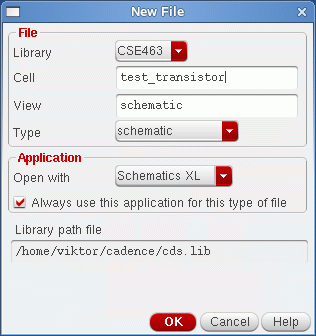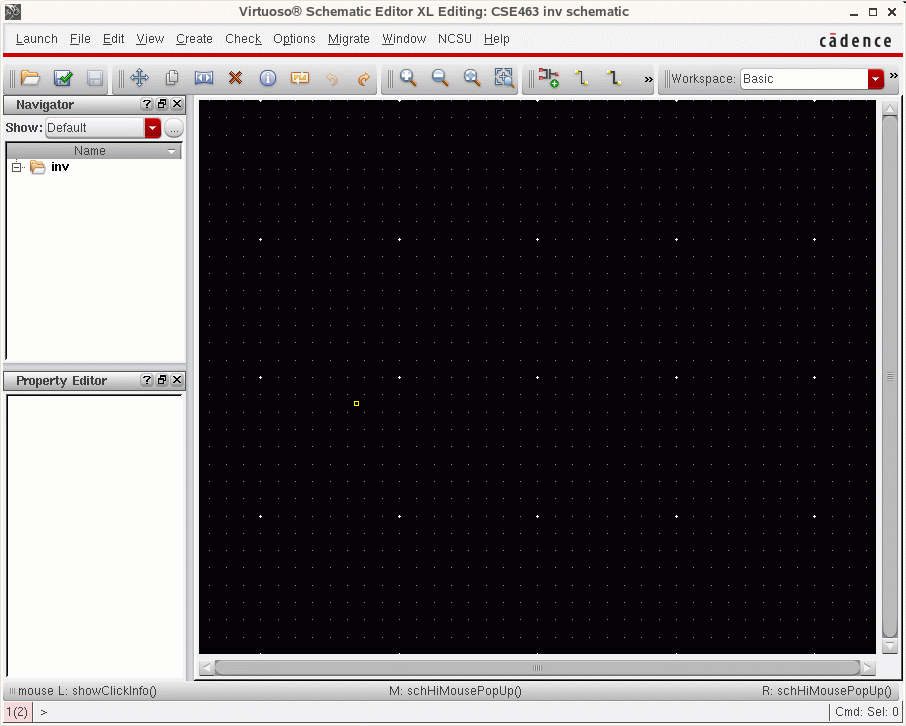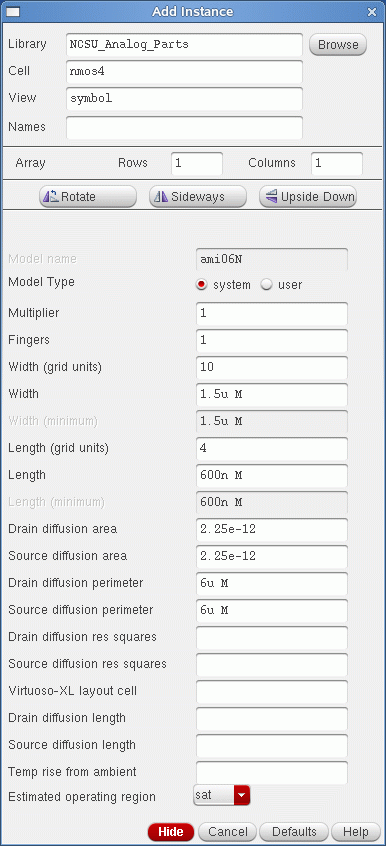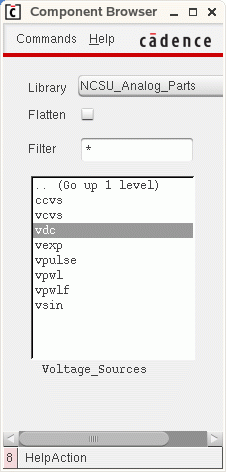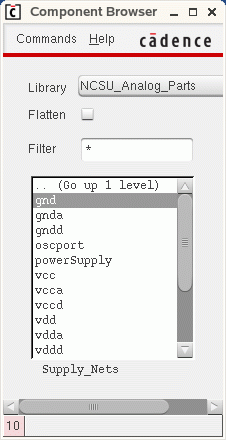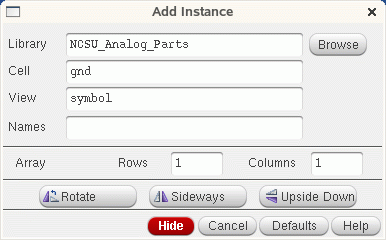Difference between revisions of "Tutorials:Cadence:CreatingSchematicTransistorIV"
| Line 58: | Line 58: | ||
Once you are done editing, left click the "check mark" icon on the left side of the screen. This will check your work for connection errors and will save your work in the library. You can accomplish the same thing by left clicking '''Schematic Editing:File → Check and Save''' | Once you are done editing, left click the "check mark" icon on the left side of the screen. This will check your work for connection errors and will save your work in the library. You can accomplish the same thing by left clicking '''Schematic Editing:File → Check and Save''' | ||
| + | |||
| + | |||
| + | [[Tutorials:Cadence:CreatingNewLibrary|Prev]] : [[Tutorials:Cadence:TransistorDCAnalysis|Next]] : [[Tutorials:Cadence:Main|Up]] | ||
---- | ---- | ||
{{Template:CadenceDisclaimer}} | {{Template:CadenceDisclaimer}} | ||
Revision as of 17:00, 10 November 2010
Creating Schematic for Transistor Testing
Click: Library Manager:New → Cellview ...
The create new file form should appear as shown bellow. We will be making a test transistor schematic, so type test_transistor in the Cell block. In the View block type schematic or from the Type pull-down menu choose schematic and the View block will be automatically filled. In the Application section, select the following: Open with: Schematic XL and check the box next to Always use this application for this type of file. Once you make these two selection, in the future they will be automatically selected.
Left click the OK button.
The Virtuoso-Schematic Editing window should be showing on your screen as shown in the figure bellow:
Left click: Schematic Editing:Add → Instance...
Shortcuts. You may notice letters by some of these menu choices. Rather than clicking through all the menus, you can just hit that button on the keyboard to the same effect. These are called hot-keys. In the future, you can press i in order to insert an instance.
A Command Browser window appears. In this window, select NCSU_Analog_parts under Library pull down menu. Next click on the nmos4 selection. The window should look as shown in the figure below.
Once you select nmos4, an Add Instance window appears. Type nmos4 to choose a four terminal NMOS transistor in the Cell Name box and symbol in the View Name box. Note that you can use the Browse button in order to browse through the libraries and find the cell you want. You can edit the parameters of the nmos4 cell, such as width, length, etc. For this exercise, keep the default parameters. The Add Instance window is shown in the figure bellow.
Move the cursor into the editing window. Notice that there is a NMOS transistor there instead of the normal cursor. Position it where you want to put the transistor, and left click to place it. You can right click to rotate the transistor if you want it to face a different direction (this is especially useful with pins).
Press <Esc> to return to a normal cursor after you have finished placing all the transistors you want. For this inverter example, place it on the bottom half of the screen on the right side of the center-line. To rotate press "r".
To make life easier?
Before trying to place a component, left click the Hide button on the Add Component window. This will move it into the background so it's out of your way.
Now we want to add voltage DC sources. Left Click Editing: Add → Instance. In NCSU_Analog_Parts library; you will find vdc sources. Place them in the test circuit. Left Click Editing:Add → Instance. In NCSU_Analog_Parts library, under Voltage_Sources category, you will find vdc source. Place them in the test circuit. The Component Browser should look like the one bellow:
Select Vdc and Add Instance window will appear. In the DC Voltage field enter 5V. This window should appear as such:
Place the symbol to the left of the transistor. Now we want to add ground lines. Left Click Editing: Add → Instance. In NCSU_Analog_Parts library, under Supply_Nets category, you will find gnd symbol. Place it in the test circuit. The Component Browser should look like the one bellow.
Once you select the NCSU_Analog_Parts selection and select Supply_Nets, you will find gnd symbol. The Add Instance windows for gnd should look like the one bellow:
Now, we'll add all the wires to make the circuit work. Click Editing: Add → Wire. The Add Wire form should appear. Just click its Hide button. You can refer to the figure bellow to see how everything is connected together.
Notice that as you get closer to one pin than another (including those on devices), a small diamond will show up inside of or around that pin. That is where you want to click to connect a wire. Also, when wiring schematic, leave the wire width at 0, Route method at full, and (usually) Draw Mode as route. This tells that software to auto-route the wires for you. If you put a wire where you don't want it to go, you can delete the wire by left clicking Editing:Edit → Delete and then left click on the object you want to delete (wire, pin, component, etc. )
A picture of what the circuit should look like is shown below:
Once you are done editing, left click the "check mark" icon on the left side of the screen. This will check your work for connection errors and will save your work in the library. You can accomplish the same thing by left clicking Schematic Editing:File → Check and Save
Information is provided "as is" without warranty or guarantee of any kind. No statement is made and no attempt has been made to examine the information, either with respect to operability, origin, authorship, or otherwise.
Please use this information at your own risk--and any attempt to use this information is at your own risk--we recommend using it on a copy of your data to be sure you understand what it does and under what conditions. Keep your master intact until you are personally satisfied with the use of this information within your environment."
Cadence® is a trademark of Cadence Design Systems, Inc., 555 River Oaks Parkway, San Jose, CA 95134
For web related questions contact: Viktor Gruev, Michael Hall
